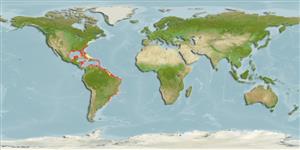Environment: milieu / climate zone / depth range / distribution range
Écologie
marin récifal; profondeur 1 - 80 m (Ref. 5217). Subtropical; 42°N - 35°S, 98°W - 28°W
Western Atlantic: North Carolina, USA, the northern Gulf of Mexico and the Bahamas southward to Uruguay. Occurrence in western Caribbean is doubtful (Ref. 26938).
Length at first maturity / Taille / Poids / Âge
Maturity: Lm 12.9 range ? - ? cm
Max length : 30.0 cm TL mâle / non sexé; (Ref. 7251); common length : 16.0 cm TL mâle / non sexé; (Ref. 5217)
Épines dorsales (Total) : 10; Rayons mous dorsaux (Total) : 12; Épines anales: 3; Rayons mous anaux: 7 - 8. Body pale brown dorsally with several vertical dark brown bars, becoming white ventrally; dorsal fin dusky with longitudinal yellow lines; pectoral, pelvic and anal fins dusky; caudal fin dusky with small yellow blotches (Ref. 13608). Preopercle has spines radiating from 2 centers (Ref. 26938).
Inhabits bays, coastal grassy areas and shallow banks. Solitary (Ref. 26340) and retreats into shelter when frightened (Ref. 9710). Neither opercular spine nor anterolateral glandular grooves with venom gland is present (Ref. 57406). Synchronously hermaphroditic. Popular as a pan fish despite its small size.
Life cycle and mating behavior
Maturité | Reproduction | Frai | Œufs | Fécondité | Larves
Simultaenous hermaphrodite. The gonad contains ovarian and testicular tissue separated by a thin basement membrane, with no means of internal self-fertilization.
Robins, C.R. and G.C. Ray, 1986. A field guide to Atlantic coast fishes of North America. Houghton Mifflin Company, Boston, U.S.A. 354 p. (Ref. 7251)
Statut dans la liste rouge de l'IUCN (Ref. 130435: Version 2024-2)
Utilisations par l'homme
Pêcheries: commercial; pêche sportive: oui
Outils
Articles particuliers
Télécharger en XML
Sources Internet
Estimates based on models
Preferred temperature (Ref.
123201): 21.9 - 28, mean 25.2 °C (based on 542 cells).
Phylogenetic diversity index (Ref.
82804): PD
50 = 0.5002 [Uniqueness, from 0.5 = low to 2.0 = high].
Bayesian length-weight: a=0.00912 (0.00747 - 0.01114), b=3.10 (3.05 - 3.15), in cm total length, based on LWR estimates for this species (Ref.
93245).
Niveau trophique (Ref.
69278): 4.5 ±0.0 se; based on diet studies.
Generation time: 3.8 ( na - na) years. Estimated as median ln(3)/K based on 2
growth studies.
Résilience (Ref.
120179): Haut, temps minimum de doublement de population inférieur à 15 mois (K=0.29-1.5; tm=1.01).
Fishing Vulnerability (Ref.
59153): Low vulnerability (15 of 100).
Climate Vulnerability (Ref.
125649): Moderate vulnerability (36 of 100).
Nutrients (Ref.
124155): Calcium = 45.5 [21.2, 110.6] mg/100g; Iron = 0.928 [0.416, 1.865] mg/100g; Protein = 19.6 [17.6, 21.4] %; Omega3 = 0.276 [0.136, 0.546] g/100g; Selenium = 21.5 [9.2, 50.2] μg/100g; VitaminA = 46.5 [12.7, 213.2] μg/100g; Zinc = 0.712 [0.414, 1.183] mg/100g (wet weight);
